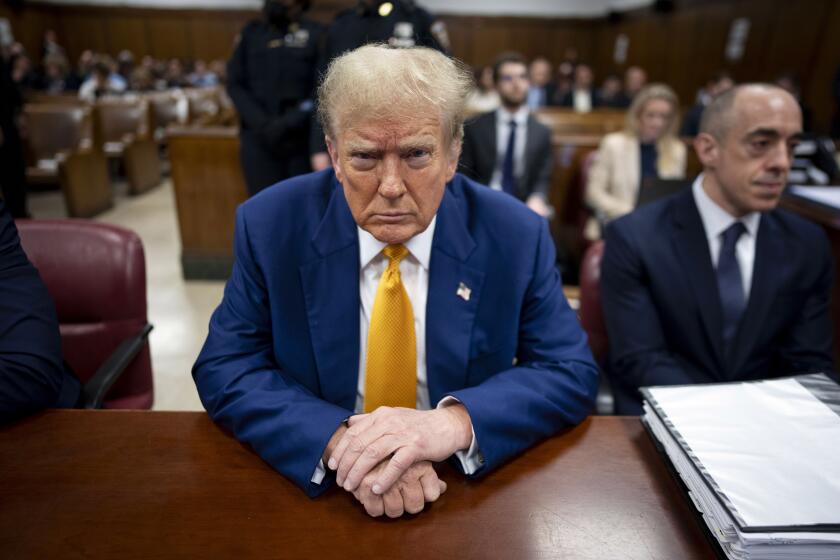High Court Term Marked by Justices’ Refusal to Be Pushed to the Right
The Supreme Court began its term last October facing a wide range of politically volatile cases and an ambitious bid by the Reagan Administration to push the justices to the right on major social issues.
By the time the court adjourned earlier this week, however, it had advanced the causes of civil rights and of feminists and other liberal groups--and dealt sharp setbacks to conservatives and the Administration.
The government lost high-profile attempts to abolish the right to abortion, expand protection for the newborn handicapped, limit the scope of new federal voting rights legislation and bar special job preferences for minorities who cannot show that they personally suffered discrimination.
Potential for Change
But close votes by the justices in pivotal cases underscored the potential for dramatic change if a moderate or liberal member of an aging court should leave the bench during President Reagan’s tenure. Administration critics concede that their victories could prove short-lived.
“Perhaps the most striking aspect of the term was the court’s consistent rejection of the extreme legal positions advanced by the Administration,” said Burt Neubourne, legal director of the American Civil Liberties Union.
”. . . But a shift of a vote or two turns the Administration from a loser to a winner. Whether it is successful in the long run depends on any new people who join the court.”
Solicitor General Charles Fried, the government’s top lawyer before the court, acknowledged that the Administration lost in key cases. But he noted that the government continued to prevail in most of the scores of cases in which it was involved--either as a direct party or a “friend of the court”--and that several of the victories involved some of the court’s most important rulings.
Gramm-Rudman Ruling
The court upheld the Justice Department’s contention that the novel deficit-reduction mechanism of the Gramm-Rudman law was unconstitutional. And the court sided with Washington state school authorities backed by the Administration in upholding a ban on indecent speech by high school students.
But at least one conservative legal observer believes that the Administration this term suffered “the most pronounced rebuff” the court has dealt the chief executive in 50 years.
“They’ve pushed in areas where the court seems most resistant,” said Bruce Fein, adjunct scholar at the American Enterprise Institute for Public Policy Research. “The justices aren’t dumb. . . . They have to wonder whether some of these cases are being brought out of a strength of conviction or just for political benefit.”
On major constitutional questions, the court chose an activist route in deciding for the first time that the time-honored practice of political gerrymandering may be challenged in court and found unconstitutional when it “consistently degrades” the voting strength of a party not in power.
Not since the 1960s, when they held that legislative redistricting was subject to court review and that reapportionment must follow the “one-man, one-vote” rule, had the justices so willingly entered the thicket of partisan politics.
‘Judicial Restraint’
But, in another big case, the court chose the course of “judicial restraint” when it held that the Constitution does not protect private homosexual conduct from prosecution under state laws prohibiting sodomy.
The justices stressed that the question was not whether such statutes were wise--but whether courts should step in to overturn laws that date to the 18th Century and are still in effect in 24 states.
In deciding another constitutional issue of far-reaching practical importance, the justices ruled that Congress, in enacting the Gramm-Rudman law, had intruded on the power of the executive branch by giving authority to the comptroller general, an officer under congressional control, to specify the cuts required to meet deficit-reducing targets.
The decision left intact the law’s goal of balancing the budget by 1991--but it gave Congress the politically difficult choice of deciding whether to vote the cuts itself.
Next term, the makeup of the court is set to change with the retirement of Chief Justice Warren E. Burger, the elevation to chief justice of Justice William H. Rehnquist and the addition of federal Court of Appeals Judge Antonin Scalia.
Major Change Unlikely
In essence, one conservative, Scalia, is replacing another, Burger, and few legal observers expect any immediate major change in the court’s course. But, together, Rehnquist and Scalia--both regarded as perhaps more personable and persuasive than Burger--are likely to add strength to the court’s conservative bloc.
The court term included important decisions on a wide array of issues, including:
AFFIRMATIVE ACTION. The justices, by a vote of 5 to 4, struck down as unconstitutional a teacher layoff plan that protected racial minority members at the expense of whites with more seniority.
But, on another 5-4 vote, they upheld court-ordered membership quotas for a union found responsible for “egregious” discrimination against minority members. And, in a 6-3 ruling, the justices affirmed a court-approved voluntary agreement between municipal officials and black firefighters for minority promotion quotas.
‘Colorblind’ Policy
The court pointedly rejected the fundamental principle of the Administration’s plea for “colorblind” civil rights policies: that quotas are never permissible and that special treatment in the workplace must be limited to the actual victims of discrimination.
ABORTION. The justices rejected the Administration’s heavily publicized plea to abandon their controversial 1973 ruling establishing a constitutional right to abortion. In a 5-4 decision, the court struck down a Pennsylvania law placing restrictions on the availability of abortion. The majority used strong, almost defiant language to reaffirm the 1973 ruling, Roe vs. Wade.
THE DEATH PENALTY. The court, rejecting one of the last few broad constitutional challenges to capital punishment, held that people who would never vote for the death penalty may be excluded from juries in capital punishment trials. The justices rejected the contention that prosecutors’ longtime practice of eliminating such persons unfairly forced defendants to face “conviction prone” juries.
JURY BIAS. The justices, in overruling a 21-year-old precedent, held that prosecutors may not use peremptory challenges--for which no cause must be stated--to exclude prospective jurors solely because of race. The court turned aside pleas from law enforcement officials and the Administration to continue to allow prosecutors wide discretion in exercising such challenges.
VOTING RIGHTS. In rejecting the Administration’s interpretation of new amendments to the Voting Rights Act, the court made it easier for blacks to challenge legislative redistricting that effectively reduces their electoral strength, whether or not that was the intention of the plan. Bipartisan sponsors of the legislation, along with the Republican National Committee, joined with civil rights groups to oppose the Administration.
RELIGION AND GOVERNMENT. The court upheld the authority of the military to bar an Orthodox Jewish Air Force officer from wearing a yarmulke, or skullcap, while on duty. It ruled also that government officials may assign a Social Security number to an American Indian child, over her parents’ religious objections, as a condition of the family’s receiving food stamps.
HANDICAPPED INFANTS. In invalidating the Administration’s “Baby Doe” regulations, the justices refused to allow federal authorities to overrule the wishes of parents and require medical treatment for severely impaired newborn infants.
SEX DISCRIMINATION. The court, in its first review of a newly emerging issue, held that employers may be sued under federal civil rights law for allowing sexual harassment in the workplace, even when the victim is not threatened with job loss. Sexual advances or other misconduct that creates a “hostile environment” for employees is grounds for a sex discrimination suit, the justices said. But they said also that firms may not automatically be held responsible for actions by a supervisor if they were unaware of them.
SEARCH AND SEIZURE. The court approved warrantless aerial surveillance by police officers of a residential backyard marijuana patch and by government environmental officials of a chemical firm facility suspected of causing air pollution.
POLICE INTERROGATIONS. In upholding law enforcement officials and the Administration, the court said that officers need not inform a suspect that a lawyer retained to advise him by a third party wants to see him. Nor does the fact that officers misled the attorney about the status of their interrogation of the suspect violate the suspect’s rights, it said.
COURT ACCESS. The justices, expanding recent rulings guaranteeing access to criminal proceedings, held that, under the Constitution, the public and the press ordinarily may not be excluded from pretrial hearings, even if the defendant requests such exclusion.
LIBEL PROTECTIONS. In significant victories for news organizations, the court said that private figures who bring libel suits must prove that defamatory statements are false--rather than the defendants’ having to prove them true--and that plaintiffs must present “clear and convincing” evidence of malicious publication of false statements to take a libel case to trial.
ATTORNEY FEES. In a costly defeat for municipal authorities and the Administration, the court said that attorneys who bring successful civil rights suits may collect more in fees than they win for their clients in damage awards. The justices upheld a fee of $245,456--not including interest--for two lawyers who won $33,350 for eight people in a suit against the city of Riverside, Calif.
More to Read
Get the L.A. Times Politics newsletter
Deeply reported insights into legislation, politics and policy from Sacramento, Washington and beyond. In your inbox three times per week.
You may occasionally receive promotional content from the Los Angeles Times.






